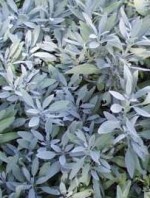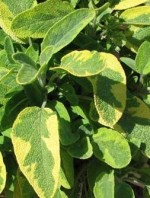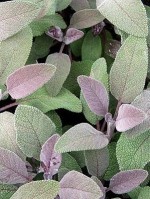 Common sage is a perennial subshrub and a member of the deadnettle family, Lamiaceae, that also includes basil, mint, and beebalm. It is native to the southern Mediterranean coast including North Africa where it grows in full sun and dry well-drained soil. The plant grows 2-2.5’ tall and has wiry, wood square stems covered with fine hairs. The grayish green leaves are carried on long petioles and are up to 4” long. They are puckered, covered with soft hairs, and are very aromatic when crushed. The two-lipped tubular flowers are up to 1” long and grow in whorls of 4-8 at the axils. They appear in early summer and may be pink, purple, blue, or white. Butterflies and bees love them. The genus name, Salvia, comes from the Latin word salveo meaing save or heal and refers to the medicinal atrritubes of the plant. The specific epithet, officinalis, is derived from the name of the storeroom in monasteries where medicines were kept and is used for plants with real or supposed medicinal properties.
Common sage is a perennial subshrub and a member of the deadnettle family, Lamiaceae, that also includes basil, mint, and beebalm. It is native to the southern Mediterranean coast including North Africa where it grows in full sun and dry well-drained soil. The plant grows 2-2.5’ tall and has wiry, wood square stems covered with fine hairs. The grayish green leaves are carried on long petioles and are up to 4” long. They are puckered, covered with soft hairs, and are very aromatic when crushed. The two-lipped tubular flowers are up to 1” long and grow in whorls of 4-8 at the axils. They appear in early summer and may be pink, purple, blue, or white. Butterflies and bees love them. The genus name, Salvia, comes from the Latin word salveo meaing save or heal and refers to the medicinal atrritubes of the plant. The specific epithet, officinalis, is derived from the name of the storeroom in monasteries where medicines were kept and is used for plants with real or supposed medicinal properties.

Type: Woody perennial herb.
Bloom: Small pink to blue flowers borne on spikes in spring.
Foliage: Heavily textured, wooly, gray-green leaves; variegated forms available with cream, rose, purple, and yellow.
Size: 20” H x 18-30” W.
Light: Full sun.
Soil: Average, alkaline, well-drained; likes dry soil once established.
Fertilizer: Light application of 10-10-10 fertilizer in spring can be beneficial.
Hardiness: Zones 5-8 (varies a bit with variety).
Care: In humid areas, plant where air circulation is good to reduce foliar diseases; prune after flowering to maintain compactness.
Pests and Diseases: Foliar diseases in humid areas.

Propagation: Seeds; division.
Outstanding Selections:

-
- ‘Bergartten’ (large, round leaves; hardy to zone 5).

-
- ‘Icterina’ (yellow variegated leaves; hardy to zone 7).

-
- ‘Purpurascens (reddish-purple leaves when young; hardy to zone 7).

- ‘Tricolor’ (rose, cream, and green leaves; hardy to zone 7).
